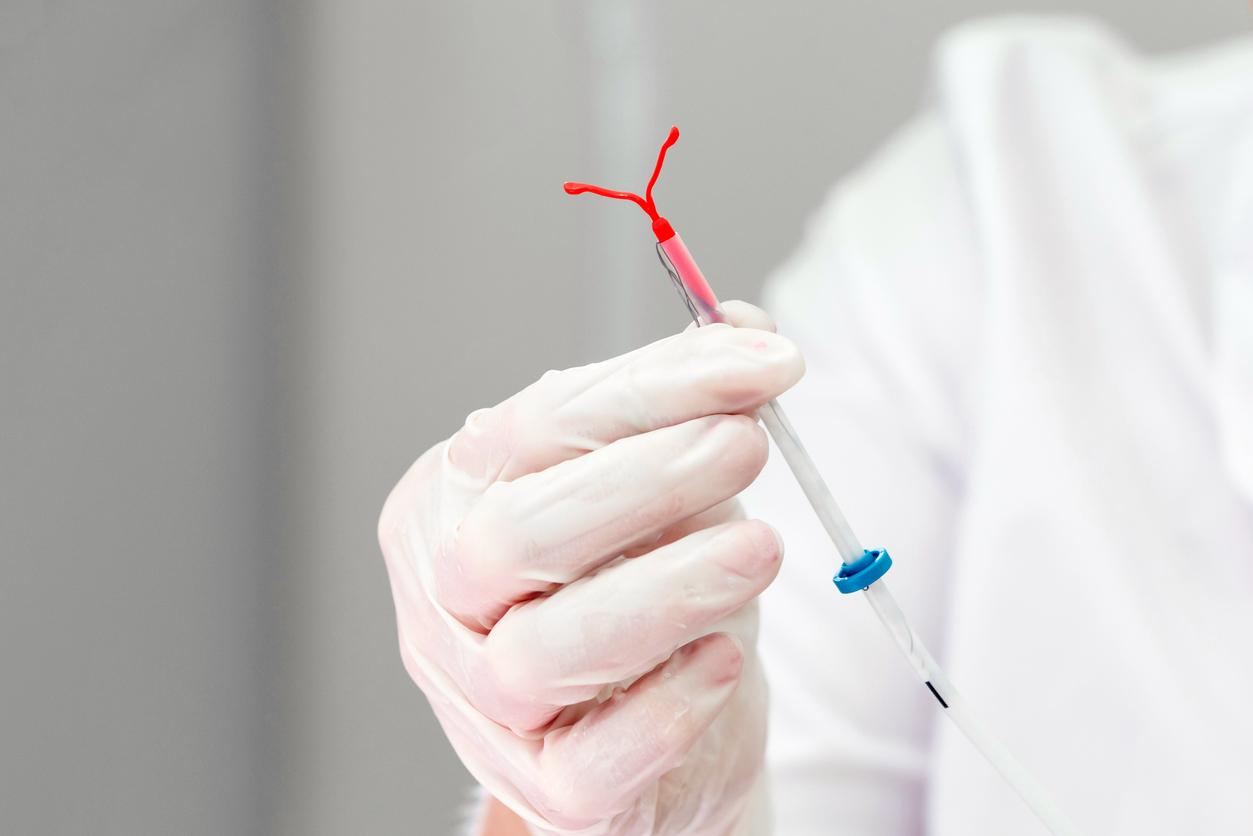SUMMARY :
- Copper IUD or hormonal IUD: how to choose?
- What are the contraindications to inserting a copper IUD?
- How is the pose going? Is it painful? Bleeding?
- Copper IUD: what are the advantages?
- What are the possible side effects ?
- Copper IUD: what effect on libido?
- How is the IUD removed?
- What price and reimbursement for a copper IUD?
the IUD also called IUD (intrauterine device) is an intrauterine device that prevents the implantation of an egg. There are two types of IUDs: one with copper without hormones the other hormonal (to progesterone). They are shaped like a T (a vertical arm and a horizontal arm) or a ball (for a brand new IUD) and measure approximately 3 cm. “The copper IUD must be fitted by a gynecologist, a treating physician with additional training or by a midwife. It has a lifespan of 3 to 10 years”informs Dr. Amina Yamgnane, Obstetrician-gynecologist Head of the Maternity Service at the American Hospital.
Copper IUD or hormonal IUD: how to choose?
Contrary to what one can sometimes hear or read, IUDs can be placed in women who have not had a pregnancy. “There are different sizes of the IUD. In women who have never given birth, we use a smaller size IUD”, says the gynecologist-obstetrician. Copper IUDs are particularly interesting for women who do not want hormonal contraception. However, if you have heavy periods, it is better to ask you a hormonal IUD (Mirena) because the copper IUD can aggravate bleeding periods. “The hormonal IUD leads to the end of periods in more than 80% of women”, informs Dr. Yamgnane. If you want to stop having periods, the hormonal IUD is a better choice.
What are the contraindications to inserting a copper IUD?
It exists two contraindications when inserting an IUD. First, a history of ectopic pregnancy. “The copper IUD increases the risk of recurrence of ectopic pregnancy”, informs Dr. Yamgnane. A malformation of the uterus (hemi-uterus, uterus with a septum, etc.) is a second contraindication to the insertion of an IUD. “The IUD does not hold well in women with a malformation of the uterus and there may be a pregnancy in the other horn when the IUD is placed in one of the horns of the uterus”, explains the obstetrician-gynecologist.
How is the pose going? Is it painful? Bleeding?
The insertion of an IUD is done after certainty of the absence of infection, and is preferably done during menstruation to be sure not to insert an IUD while there is an ongoing pregnancy (this would lead to a false layer). If the insertion takes place outside the period of rule, a pregnancy test is carried out the day before the insertion of the IUD and the IUD is inserted if the pregnancy test is negative. “The installation of an IUD can be painful, especially in women who have never given birth.informs Dr. Yamgnane. This is why I recommend taking an analgesic medication 1 to 2 hours before the appointment scheduled for the pose to make it more bearable”. An ultrasound is done just after the placement of the IUD by the gynecologist or later by a radiologist. It allows you to check that the IUD is correctly placed. “When the IUD is inserted outside of periods of menstruation, the woman may notice a slight bleeding of short duration, this is normal and nothing should be done. What should alert are bleeding, smelly vaginal discharge or incessant pain within 48 hours after insertion of the IUD”, warns the obstetrician-gynecologist. This should lead to urgent medical attention.
Copper IUD: what are the advantages?
Contraception with a copper IUD is very effective. “Its contraceptive security is comparable to that of hormonal contraception (pill, patch, ring), says Dr. Yamgnane. Other advantages of the IUD: it is a long-term contraceptive that does not require you to take care of it every day like the pill and it does not does not deliver hormones. “There is no drug interference”, adds the doctor. Ideal for women who want contraception without hormones.
What are the possible side effects ?
The copper IUD may have 3 side effects:
- It can already cause heavier periods in some women. “15% of women who have a copper IUD see their periods increase in volume and/or duration”, informs the obstetrician-gynecologist. This creates a significant social handicap and is the cause in the medium term of anemia due to iron loss. “For these women, I recommend the removal of the copper IUD and the installation of a hormonal progesterone IUD”, indicates the doctor who reassures women about the hormone level of this hormonal IUD: “The progesterone diffuses locally and the dose delivered is extremely low, 10mg of progesterone per year, which means that the total hormone level of the hormonal IUD over 5 years is 20 times lower than a single contraceptive pill “.
- In the event of an unintended pregnancy, there is a more frequent risk of ectopic pregnancy with an IUD than with a pill.
- Finally, the IUD “being a foreign body inside the uterus, if you are infected with a sexually transmitted infection (STI), the STD bacteria attach themselves to the IUD and this can cause more serious infections”, says Dr. Yamgnane. “The IUD is for this reason the contraception of choice for stable couples”. If you have many sexual partners, you must protect yourself every time you have sex with a condom, even if you already have a contraceptive method.
Copper IUD: what effect on libido?
The question of the effect of contraceptives on sexual desire is complex. So far, studies are not unanimous on the subject. What is certain is that itsome women still report a decrease in libido when they use a hormonal birth control. But in others it can be a libido booster.
Anyway, good news. the copper IUD does not contain hormones, it does not disturb the hormonal balance so it has no effect on the libido.
Some men say they feel it when penetration, in this case, it is sufficient to have the strings of your IUD cut by a doctor. It’s simple and safe for both partners.
How is the IUD removed?
Removal of the copper IUD is simple and generally less painful than insertion. The healthcare professional just has to pull on the IUD strings that are visible at the cervix. As with all other contraceptives, there is no need to stop contraception in advance.
What price and reimbursement for a copper IUD?
Contraception with a copper IUD is inexpensive contraception. “A copper IUD costs 30 or 40 euros, and 130 euros for a progesterone IUD, for an average duration of action of 5 years”, says Dr. Yamgnane. The copper IUD is reimbursed up to 65% by Social Security. Some mutuals can pay the rest. This makes it the cheapest contraception on the market!
Thank you to Dr. Amina Yamgnane, obstetrician-gynecologist Head of Maternity Services at the American Hospital.
Get informed : questionsexuality.
Read also:
- Defective IUDs: the Medicines Agency encourages women to consult
- Testimonial – Vasectomy “to finally take responsibility for contraception in the couple”
- Contraceptive ring: how to put it on? what advantages?
- What is the best birth control for me? Take the test!

















